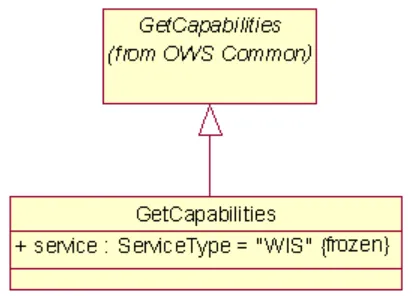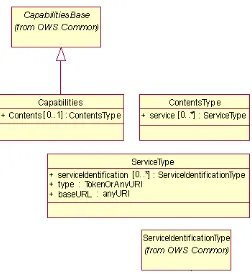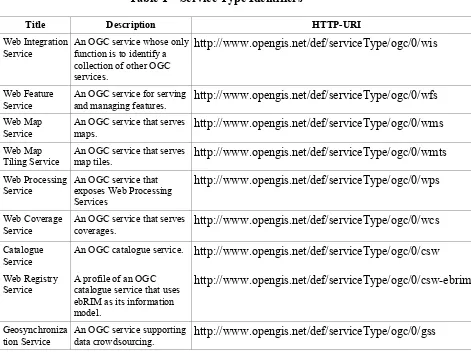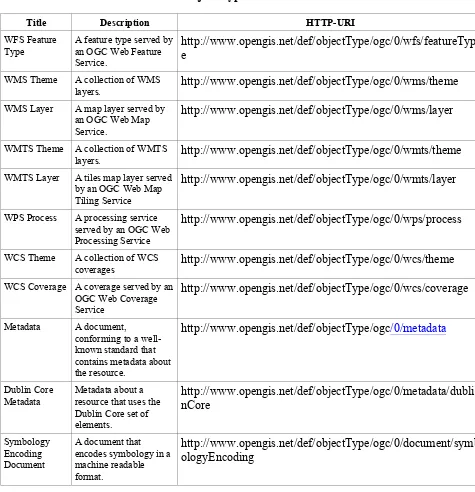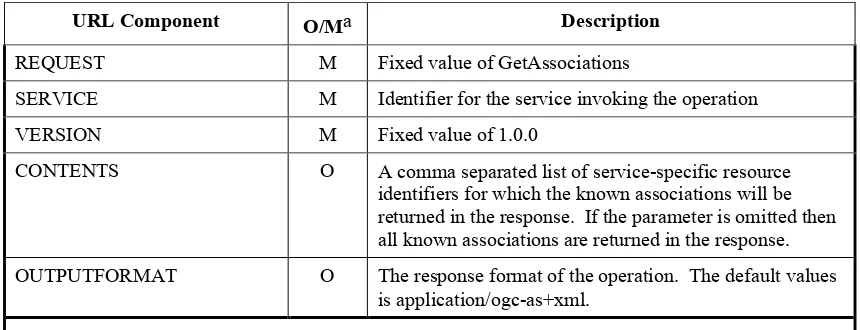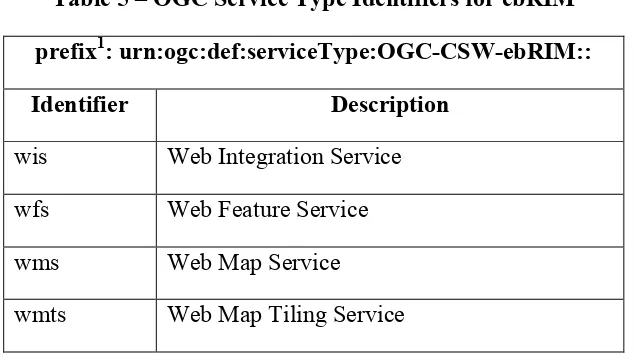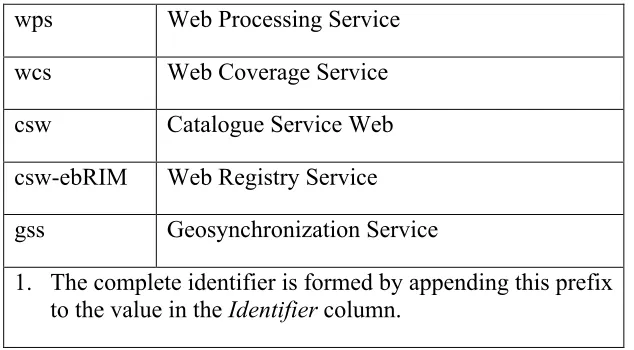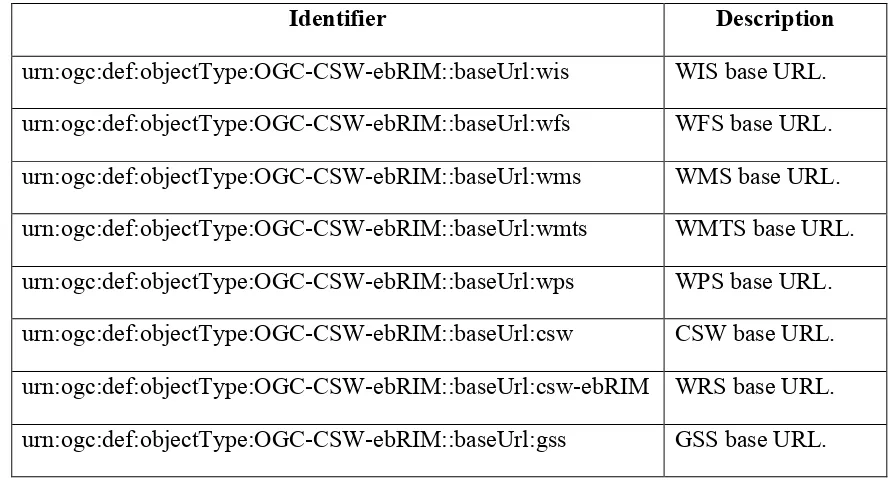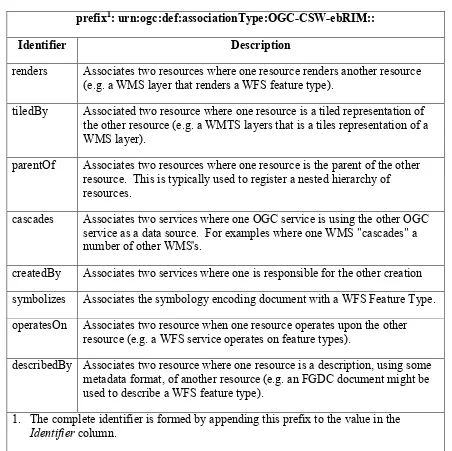Publication Date: 2014-05-19
Approval Date:2014-03-30
Submission Date:2014-03-11
Reference number of this document:OGC 14-013r1
External identifier for this document:http://www.opengis.net/doc/ER/testbed10/wis
Category: Public Engineering Report
Editor: Panagiotis (Peter) A. Vretanos
OGC
®
Testbed-10 Service Integration Engineering Report
Copyright © 2014 Open Geospatial Consortium.
To obtain additional rights of use, visit http://www.opengeospatial.org/legal/.
Warning
This document is not an OGC Standard. This document is an OGC Public
Engineering Report created as a deliverable in an OGC Interoperability Initiative
and is not an official position of the OGC membership. It is distributed for review
and comment. It is subject to change without notice and may not be referred to as
an OGC Standard. Further, any OGC Engineering Report should not be referenced
as required or mandatory technology in procurements
.
Document type:
OGC
®Engineering Report
Document subtype:
NA
Preface
For many years OGC has been developing a suite of web services for geospatial
processing. The suite includes a web map service (WMS), a web map tiling service
(WMTS), a web feature service (WFS), a web coverage service (WCS), a web catalogue
service, etc. These services have, more or less, been developed independently of one
another resulting in isolation and poor integration among them. For example, consider a
map generated by a WMS; it is not easily possible to determine which source data was
used to create the map and how to download that source data though an OGC data service
such as WFS or WCS. Furthermore when one considers the Publish-Find-Bind
License Agreement
Permission is hereby granted by the Open Geospatial Consortium, ("Licensor"), free of charge and subject to the terms set forth below, to any person obtaining a copy of this Intellectual Property and any associated documentation, to deal in the Intellectual Property without restriction (except as set forth below), including without limitation the rights to implement, use, copy, modify, merge, publish, distribute, and/or sublicense copies of the Intellectual Property, and to permit persons to whom the Intellectual Property is furnished to do so, provided that all copyright notices on the intellectual property are retained intact and that each person to whom the Intellectual Property is furnished agrees to the terms of this Agreement.
If you modify the Intellectual Property, all copies of the modified Intellectual Property must include, in addition to the above copyright notice, a notice that the Intellectual Property includes modifications that have not been approved or adopted by LICENSOR. THIS LICENSE IS A COPYRIGHT LICENSE ONLY, AND DOES NOT CONVEY ANY RIGHTS UNDER ANY PATENTS THAT MAY BE IN FORCE ANYWHERE IN THE WORLD.
THE INTELLECTUAL PROPERTY IS PROVIDED "AS IS", WITHOUT WARRANTY OF ANY KIND, EXPRESS OR IMPLIED, INCLUDING BUT NOT LIMITED TO THE WARRANTIES OF MERCHANTABILITY, FITNESS FOR A PARTICULAR PURPOSE, AND NONINFRINGEMENT OF THIRD PARTY RIGHTS. THE COPYRIGHT HOLDER OR HOLDERS INCLUDED IN THIS NOTICE DO NOT WARRANT THAT THE FUNCTIONS CONTAINED IN THE INTELLECTUAL PROPERTY WILL MEET YOUR REQUIREMENTS OR THAT THE OPERATION OF THE INTELLECTUAL PROPERTY WILL BE
UNINTERRUPTED OR ERROR FREE. ANY USE OF THE INTELLECTUAL PROPERTY SHALL BE MADE ENTIRELY AT THE USER’S OWN RISK. IN NO EVENT SHALL THE COPYRIGHT HOLDER OR ANY CONTRIBUTOR OF
INTELLECTUAL PROPERTY RIGHTS TO THE INTELLECTUAL PROPERTY BE LIABLE FOR ANY CLAIM, OR ANY DIRECT, SPECIAL, INDIRECT OR CONSEQUENTIAL DAMAGES, OR ANY DAMAGES WHATSOEVER RESULTING FROM ANY ALLEGED INFRINGEMENT OR ANY LOSS OF USE, DATA OR PROFITS, WHETHER IN AN ACTION OF CONTRACT, NEGLIGENCE OR UNDER ANY OTHER LEGAL THEORY, ARISING OUT OF OR IN CONNECTION WITH THE IMPLEMENTATION, USE, COMMERCIALIZATION OR PERFORMANCE OF THIS INTELLECTUAL PROPERTY. This license is effective until terminated. You may terminate it at any time by destroying the Intellectual Property together with all copies in any form. The license will also terminate if you fail to comply with any term or condition of this Agreement. Except as provided in the following sentence, no such termination of this license shall require the termination of any third party end-user sublicense to the Intellectual Property which is in force as of the date of notice of such termination. In addition, should the Intellectual Property, or the operation of the Intellectual Property, infringe, or in LICENSOR’s sole opinion be likely to infringe, any patent, copyright, trademark or other right of a third party, you agree that LICENSOR, in its sole discretion, may terminate this license without any compensation or liability to you, your licensees or any other party. You agree upon termination of any kind to destroy or cause to be destroyed the Intellectual Property together with all copies in any form, whether held by you or by any third party. Except as contained in this notice, the name of LICENSOR or of any other holder of a copyright in all or part of the Intellectual Property shall not be used in advertising or otherwise to promote the sale, use or other dealings in this Intellectual Property without prior written authorization of LICENSOR or such copyright holder. LICENSOR is and shall at all times be the sole entity that may authorize you or any third party to use certification marks, trademarks or other special designations to indicate compliance with any LICENSOR standards or specifications.
This Agreement is governed by the laws of the Commonwealth of Massachusetts. The application to this Agreement of the United Nations Convention on Contracts for the International Sale of Goods is hereby expressly excluded. In the event any provision of this Agreement shall be deemed unenforceable, void or invalid, such provision shall be modified so as to make it valid and enforceable, and as so modified the entire Agreement shall remain in full force and effect. No decision, action or inaction by LICENSOR shall be construed to be a waiver of any rights or remedies available to it.
Contents
Page
1
Introduction ... 1
1.1
Scope ... 1
1.2
Document contributor contact points ... 3
1.3
Future work ... 3
1.4
Forward ... 3
2
References ... 4
3
Terms and definitions ... 4
4
Conventions ... 8
4.1
Abbreviated terms ... 8
4.2
UML notation ... 8
5
Use cases ... 8
5.1
Introduction ... 8
5.2
Catalogue use cases ... 8
5.2.1
Service identification use case ... 8
5.2.2
Service discovery use case ... 9
5.2.3
Service harvesting use case ... 9
5.2.4
Rich discovery use case ... 9
5.3
Direct client-server use cases ... 9
5.3.1
Efficient navigation use case ... 9
5.3.2
Rendering use case ... 10
5.3.3
Cascading use case ... 10
5.3.4
Data download use case ... 10
6
Elements of the solution ... 10
6.1
Introduction ... 10
6.2
Evolutionary refinement ... 10
6.3
Auto-discovery ... 11
6.4
Auto-description ... 11
6.5
Cataloging ... 11
7
Web Integration Service ... 12
7.1
Introduction ... 12
7.2
GetCapabilities operation ... 12
7.2.1
Request ... 12
7.2.1.1
UML ... 12
7.2.1.2
KVP encoding ... 12
7.2.1.3
XML encoding ... 13
7.2.2
Response ... 13
7.2.2.2
XML encoding ... 14
7.3
NoOp operation ... 15
7.4
Example ... 15
8
Associations and the GetAssociations operation ... 19
8.1
Introduction ... 19
8.2
Associations ... 20
8.2.1
Introduction ... 20
8.2.2
Types of association resources ... 20
8.2.3
UML ... 21
8.2.4
XML-encoding ... 21
8.2.5
Associations container ... 22
8.2.6
MIME type ... 23
8.3
Standard identifiers ... 23
8.4
GetAssociations operation ... 26
8.4.1
Introduction ... 26
8.4.2
UML ... 26
8.4.3
KVP-encoding ... 28
8.4.4
XML-encoding ... 28
8.4.5
Response ... 29
8.4.6
Example ... 29
9
Catalogue extensions ... 30
9.1
Introduction ... 30
9.2
Identifiers ... 31
9.2.1
Introduction ... 31
9.3
Identifiers for OGC web services for ebRIM ... 31
9.4
Identifier for the content of OGC web services for ebRIM ... 32
9.5
Identifiers for OGC documents for ebRIM ... 33
9.6
Identifiers for associations for ebRIM ... 34
9.7
Identifiers for ebRIM slot names ... 36
9.8
Identifiers for data types for ebRIM ... 38
9.9
Classification schemes for ebRIM ... 39
9.10
Mapping OGC capabilities documents into ebRIM ... 39
9.10.1
Introduction ... 39
9.10.2
ServiceIdentification section ... 39
9.10.3
ServiceProvider section ... 40
9.10.4
OperationsMetadata section ... 41
9.10.5
Content section ... 42
9.10.5.1
Introduction ... 42
9.10.5.2
WIS content ... 42
9.10.5.3
WMS content ... 42
9.10.5.4
WMTS content ... 44
9.10.5.5
WFS feature types ... 46
9.10.5.6
WCS Converage ... 46
Annex A XML Schema Documents (normative) ... 48
OGC
®
Testbed-10 Service Integration Engineering Report
1
Introduction
1.1
Scope
This document specifies technical changes to the OGC web service architecture baseline
to support better integration among the services. Although integration may be achieve in
a number of ways and using a number of other technologies, the goal of this document is
to achieve this integration within the current OGC service framework in order to leverage
existing investments in OGC web services infrastructure.
Two groups of use cases have been developed to illustrate the needs of an integrated suite
of OGC web services: (a) catalogue use cases and (b) direct client-server uses cases. The
catalogue use cases include the following:
Service identification use case
Service discovery use case
Service harvesting use case
Rich discovery use case
The direct client-service use cases include the following:
Efficient data navigation use case
Rendering use case
Cascading use case
Data download use case
This document establishes a new service, called the
Web Integration Service
(WIS),
which allows for the discovery and access to integrated sets of OGC web services
deployed at an endpoint.
associations is accomplished by the definition of an XML Schema for expressing
associations in XML. As mentioned earlier, the scope of this document is limited to the
existing OGC web service framework, which predominantly uses XML. However, it is
anticipated that over time the association schemas defined in this document will be
extended to provide a JSON expression, which is a rapidly emerging encoding both
within and outside the OGC.
For the purpose of catalogue harvesting it would be very useful to have a unique service
identifier for each service instance. This document also specifies changes to the existing
OGC Capabilities document schema to include a “ServiceId” element whose value is a
UUID (see IETF RFC 4122) that uniquely identifies an OGC web service instance.
Currently, OGC catalogues can harvest the capabilities document of an OGC web
service, register that service, register the existence of the individual data items that the
service offers and also register the association between the service and the data it offers.
Thus, the entire harvesting process is focused on a single OGC web service. There is
currently no defined method that allows a catalogue to determine and harvest associations
that might exist between the service being harvested and other services and other data
offerings. This document also specifies changes to the current OGC web service baseline
to support the harvesting of this richer set of metadata by providing the means for a
catalogue to register a service, the data the service offers and also all the associations
between the service, its data, other OGC web resources (i.e. other OGC services and data
offerings) and other non-OGC web resources. A component of this enhanced harvesting
capability is the definition of a CSW-ebRIM package that defines ebRIM object types,
associations and classifications that support the description of integrated OGC web
services and their artifacts within the catalogue.
Having defined the methods and apparatus for harvesting a richer set of metadata about
OGC web services, this document also specifies how this metadata can be discovered
once it has been registered in a catalogue. For example, a client should be able to find the
description of feature data in a catalogue and then be able to find the WFS that offer that
data, a WMS that renders those features into a map, a WMTS that has a tiled
representation of that data, etc. This enhanced discovery capability is provided by a set
of stored queries defined in a CSW-ebRIM package specified in this document to support
the description of integrated OGC web services.
An OWS Context Document presents a list of items and not necessarily a list of services.
An item can have one or more services associated and thus allowing the client to select
the preferred end-point and encoding of the information represented in the item. A
catalogue or an application producing OWS Context Documents has to obtain those
associations and be able to aggregate them as the same item accessed by different
services.
Moreover, as in for the catalogue harvesting mentioned above, the OWS Context
Document offers no method to define associations that might exist between the different
items. It is expected that the association defined in this document will support OWS
Context clients in organizing and managing the different information items.
1.2
Document contributor contact points
All questions regarding this document should be directed to the editor or the contributors:
Name Organization Email Address
Panagiotis (Peter) A. Vretanos CubeWerx Inc. pvretano [at] cubewerx.com
Pedro Gonçalves Terradue pedro.goncalves [at] TERRADUE.COM
1.3
Future work
Although any OGC web service can participate as part of an integrated suite of OGC
services, this document primarily focuses its discussion and examples of the “classical”
OGC web service of WMS, WMTS, WFS, WCS, WPS and CSW. Future revisions
would expand the examples and discussion to include a broader range of OGC service
including the SOS suite of services.
The data structures defined in this are document are primarily encoded using XML. In
the future a JSON encoding will also be required as JSON is quickly emerging as the
preferred encoding and serialization of data exchanged on the web.
1.4
Forward
Attention is drawn to the possibility that some of the elements of this document may be
the subject of patent rights. The Open Geospatial Consortium shall not be held
responsible for identifying any or all such patent rights.
2
References
The following documents are referenced in this document. For dated references,
subsequent amendments to, or revisions of, any of these publications do not apply. For
undated references, the latest edition of the normative document referred to applies.
IETF RFC 3986,
Uniform Resource Identifier (URI): Generic Syntax
IETF RFC 4122,
A Universally Unique IDentifier (UUID) URN Namespace
IETF RFC 5988,
Web Linking
OASIS regrep-rim-3.0-os,
ebXML Registry Information Model, Version 3.0
OGC 12-084r2,
OWS Context Atom Encoding
OGC 12-080,
OWS Context Conceptual Model
OGC 10-069r2,
OWS-7 Engineering Report - Geosynchronization service
OGC 09-025r1,
OpenGIS Web Feature Service 2.0 Interface Standard (also ISO 19142)
OGC 07-110r4,
CSW-ebRIM Registry Service - Part 1: ebRIM profile of CSW
OGC 07-144r4,
CSW-ebRIM Registry Service - Part 2: Basic extension package
OGC 07-057r7,
OpenGIS Web Map Tile Service Implementation Standard
OGC 07-006r1,
OpenGIS Catalogue Service Implementation Specification
OGC 06-121r9,
OGC
®Web Services Common Standard
OGC 06-042,
OpenGIS Web Map Service (WMS) Implementation Specifica
tion
OGC 05-076,
OpenGIS Web Coverage Service (WCS) Implementation Specification
In addition to this document, this report includes several XML Schema Document files as
specified in Annex A and Annex B.
3
Terms and definitions
3.1
attribute
<XML>
name-value pair contained in an element
[ISO 19136:2007]
Note: In this document an attribute is an XML attribute unless otherwise specified.
3.2
association
named or typed connection between two web resources
3.3
baseURL
URL to which parameters of the GetCapabilities operation are appended to form a valid
request
NOTE: assuming that the name of root element of the capabilities document is
“root_element” the XPath expression for getting the baseURL is:
/root_element/OperationsMetadata/Operation[name="GetCapabilities"]/DCP/HTTP/Get/@xlink.href
3.4
client
software component that can invoke an operation from a server
[ISO 19128:2005]
3.5
coordinate
one of a sequence on n numbers designating the position of a point in n-dimensional
space
[ISO 19111:2007]
3.6
coordinate reference system
coordinate system that is related to an object by a datum
[ISO 19111:2007]
3.7
coordinate system
set of mathematical rules for specifying how coordinate are to be assigned to points
[ISO 19111:2007]
3.8
element
<XML>
basic information item of an XML document containing child elements, attributes and
character data
3.9
feature
abstraction of real world phenomena
[ISO 19010:2002]
NOTE: A feature can occur as a type or an instance. The term “feature type” or “feature
instance” should be used when only one is meant.
3.10
feature identifier
identifier that uniquely designates a feature instance
3.11
filter expression
predicate expression encoded using XML
[ISO 19143]
3.12
Harvest operation
an operation defined by the CSW standard that may be used to automatically register
resources (e.g. services) with the catalogue
3.13
interface
named set of operations that characterize the behavior of an entity
3.14
link
synonym for association
3.15
link relation
identifies the semantics of a link
NOTE: Typically specified using the “rel” attribute of a link or association
3.16
namespace
<XML>
collection of names, identifier by a URI reference which are used in XML documents as
element names and attribute names
[W3C XML Namespaces]
3.17
operation
3.18
OGC web service resource
resource that is accessible through an OGC web service
NOTE: Examples of OGC web service resource include WMS layer, WFS feature type &
WCS coverage. Essentially any resource that you can only access through a OGC service
API is an “OGC web service resource”
3.19
property
face or attribute of an object, referenced by name
[ISO 19143]
3.20
response
result of an operation returned from a server to a client
[ISO 19128:2005]
3.21
server
particular instance of a service
[ISO 19128:2005]
3.22
service
distinct part of the functionality that is provided by an entity through interfaces
[ISO 19119:2005]
3.23
service metadata
metadata describing the operations and geographic information available at a server
[ISO 19128:2005]
3.24
Uniform Resource Identifier
unique identifier for a resource, structured in conformance with IETF RFC 3986
[ISO 19136:2007] and
NOTE: The generate syntax is <scheme>::<scheme-specified-part>. The hierarchical
syntax with a namespace is <scheme>://<authority><path>?<query>
3.25
web resource
4
Conventions
4.1
Abbreviated terms
API
Application Program Interface
CSW
Catalogue Service Web
CSW-ebRIM ebRIM profile of Catalogue Service Web
GSS
GeoSynchronization Service
URL
Uniform Resource Location
URI
Uniform Resource Identifier
WMS
Web Map Service
WMTS
Web Map Tiling Service
WFS
Web Feature Service
WCS
Web Coverage Service
UUID
Universally Unique IDentifier
4.2
UML notation
Most diagrams that appear in this standard are presented using the Unified Modeling
Language (UML) static structure diagram, as described in Subclause 5.2 of [OGC
06-121r3].
5
Use cases
5.1
Introduction
This clause describes a number of use cases used to guide the development of this
engineering report.
5.2
Catalogue use cases
5.2.1
Service identification use case
In order to prevent duplicate harvesting, a catalogue should be able to determine if an
OGC web service, arrived at by a variety of different paths, is indeed the same service. It
is not trivial, for example, for a catalogue to determine that a WFS arrived at using the
URL:
is in fact the same WFS arrived at using the URL:
http://www.somecorp.com/wfs?REQUEST=GetCapabilities&version=2.0.0&servi ce=wfs&vendorId=somecorp
5.2.2
Service discovery use case
A common deployment pattern for OGC web services is to have a suite of OGC web
services deployed on top of one more spatial data repositories. For example, an
enterprise may have one or more databases containing spatial data and several OGC web
services are deployed on top of those data resources. The problem is that these services,
although notionally deployed as a suite of services, stand in isolation because there is no
means of discovering which set of OGC web services are deployed at an endpoint.
Enabling the discovery use case this allows clients to discover the set or suite of OGC
web services available at an endpoint.
5.2.3
Service harvesting use case
OGC catalogues can automatically harvest the capabilities document of OGC web
services in order to register the service, the data that the service offers and the association
between the two (e.g. wfs X offers feature type y). However, OGC catalogues cannot
automatically discover and create other associations that might exist between the service
being harvested and other resources. Enabling the harvesting use case allows a catalogue
to not only harvest an OGC web service and its offering but also allows the catalogue to
automatically discover and harvest any associations with other OGC and non-OGC
resources.
5.2.4
Rich discovery use case
Because a catalogue can currently only discover a very limited set of associations --
typically isolated to a single OGC web service -- the ability for rich discovery is severely
curtailed. The discover use case enables a client to search an OGC catalogue for rich
associations between a service, its offerings and other OGC and non-OGC resource. An
example of such rich discovery would be to search an OGC catalogue and find some
feature data. A client should then be able to discover not only the WFS that offers that
data (something that is currently possible) but also find a WMS that renders those
features onto a map or a WMTS that has a tiled representation of that data thus enabling
quick visual navigation of the data.
5.3
Direct client-server use cases
5.3.1
Efficient navigation use case
should be able to interrogate the WMS providing that map layer and determine if there is
a WMTS layer that might be used instead to more efficiently render the map.
5.3.2
Rendering use case
Given a WFS feature type or WCS coverage, a client should be able to interrogate the
corresponding service to determine if there is an available WMS/WMTS layer that
renders that data as a map.
5.3.3
Cascading use case
Given a cascaded resource a client should be able to interrogate the service to determine
the source server of the resource so that the client can decide to bypass the cascading
service and access the source service directly.
5.3.4
Data download use case
The data download use case allows a client to interactively create a map and then, by
interrogating the services used to render the map (e.g. WMS or WMTS) be able
download the underlying source data for the map. This use case typically requires the
association between WMS or WMTS layers and WFS feature types or WCS coverages to
be established.
6
Elements of the solution
6.1
Introduction
This clause described at a high level some of the elements of the proposed service
integration solution presented in this engineering report.
6.2
Evolutionary refinement
6.3
Auto-discovery
Auto-discovery is the automated discovery of OGC services at a specified endpoint. Put
another way, given a URL endpoint, an agent should be able to determine which OGC
services (WMS, WFS, WCS, WMTS, etc.) are being offered at that endpoint.
6.4
Auto-description
OGC services are already partially self-describing in that they provide metadata in the
form of a capabilities document obtained using the GetCapabilities operation that all
OGC web services must implement. The OGC capabilities document contains metadata
that describes what kind of service is being offered, who is offering the service, what
content is being offered and optionally what kind of query capabilities the service offers.
This information is useful and important but it only relates to a single service. In order to
have a richer description of a suite of OGC web services, there is a requirement that
additional metadata must be published that not only describes a specific service and its
offerings but also describes relationships or associations between that service, its
offerings and other OGC and non-OGC resources. For example, a WMS would know
that a particular layer that it offers is rendered from source feature data offered by a
particular WFS. The kind of internal knowledge (e.g. the association between a WMS
layer and a WFS feature type) needs to be externalized thus becoming harvestable and
discoverable using an OGC catalogue.
6.5
Cataloging
Currently OGC catalogues support the registration of OGC services and the contents that
they offer. Because each service is harvested in isolation of other services and resources,
only limited discovery is supported allowing a client to, for example, discover a data
resource and then find the service that offers that resource (or visa-versa).
An integrated OGC web service environment, however, requires that OGC catalogues be
extended to harvest and make discoverable a richer set of linked OGC and non-OGC
resources. A catalogue should be able to automatically register services found at an
endpoint as well as register all known associations among those services, their offerings
and other OGC and non-OGC resources. This involves harvesting a service’s capabilities
document to determine what content the service offers but it also involves further
interrogating the service to determine of what (if any) other associations it is aware.
7
Web Integration Service
7.1
Introduction
The Web Integration Service (WIS) is an aggregation service whose only purpose is to
provide a list of references to a suite of other, perhaps related OGC services available at
an endpoint.
In keeping with the evolutionary refinement and reuse goal stated in Clause 6.1, the web
integration service only defines a single operation, GetCapabilities, and responds using a
standard OGC capabilities document whose content section lists the available services
accessible at that end point.
A web integration service shall implement the KVP-encoding of the GetCapabilities
operation.
A web integration service may optionally implement the XML-encoding of the
GetCapabilities operation.
7.2
GetCapabilities operation
7.2.1
Request
7.2.1.1
UML
Figure 1 defines the schema of the GetCapabilities request.
Figure 1 – UML for GetCapabilities request
7.2.1.2
KVP encoding
7.2.1.3
XML encoding
The following XML Schema fragment defines the XML-encoding of the GetCapabilities
request.
<xsd:element name="GetCapabilities" type="wfs:GetCapabilitiesType"/> <xsd:complexType name="GetCapabilitiesType">
<xsd:complexContent>
<xsd:extension base="ows:GetCapabilitiesType">
<xsd:attribute name="service" type="ows:ServiceType" use="required" fixed="WIS"/> </xsd:extension>
</xsd:complexContent> </xsd:complexType>
7.2.2
Response
7.2.2.1
UML
The following UML diagram defines the schema for the response of a WIS. The
response is essentially a standard OGC capabilities document with a content section
composed of zero or more ows:ServiceIdentification sections each describing one OGC
web service available at the endpoint.
Each service is characterized by its type (i.e. WMS, WMTS, WFS, etc.), the base URL of
the service and the standard ServiceIdentification description of the service from Web
Service Common (see OGC 06-121r9).
The value of the “type” parameter can be a token – such as the three letter acronyms
commonly used by OGC – or a URI identifier for the service (see Table 1).
The value of the “baseURL” parameter is the service URL to which GetCapabilities
request (see 06-121r9, Clause 7) parameters are appended to form a valid request URL.
7.2.2.2
XML encoding
The following XML Schema fragment defines the schema for the XML-encoded
response to a WIS GetCapabilities request.
<xsd:element name="Capabilities" type="wis:WIS_CapabilitiesType"/> <xsd:complexType name="WIS_CapabilitiesType">
<xsd:complexContent>
<xsd:extension base="ows:CapabilitiesBaseType"> <xsd:sequence>
<xsd:element ref="wis:Contents"/> </xsd:sequence>
</xsd:extension> </xsd:complexContent> </xsd:complexType>
<xsd:element name="Contents" type="wis:ContentsType"/> <xsd:complexType name="ContentsType">
<xsd:sequence>
<xsd:element ref="wis:Service" maxOccurs="unbounded"/> </xsd:sequence>
</xsd:complexType>
<xsd:element name="Service" type="wis:ServiceType"/> <xsd:complexType name="ServiceType">
<xsd:sequence>
<xsd:element ref="ows:ServiceIdentification"/> </xsd:sequence>
<xsd:attribute name="type"
type="wis:TokenOrAnyURI" use="required"/>
<xsd:attribute name="baseUrl" type="xsd:anyURI" use="required"/> </xsd:complexType>
<xsd:simpleType name="TokenOrAnyURI">
7.3
NoOp operation
This engineering report defines an additional WIS operation named “NoOp” that all
clients shall ignore. The NoOp operation only exists to satisfy XML validation
requirements for capabilities documents imposed by the Web Service Common standard
(see OGC 06-121r9, 7.4.6) which requires that OGC web services implement the
GetCapabilities operation plus one additional operation. Clearly, the web service
common standard did not anticipate the usefulness of a service that only implements the
GetCapabilities request. A change request has been posted against OGC 06-121r9 to
remove this requirement.
7.4
Example
In response to the following request:
http://www.somcorp.com/wis?service=WIS&request=GetCapabilities
a web integration service might generate the following capabilities document:
<?xml version="1.0"?>
<Capabilities version="1.0.0"
xmlns="http://www.opengis.net/wis/1.0" xmlns:ows="http://www.opengis.net/ows/2.0" xmlns:xlink="http://www.w3.org/1999/xlink"
xmlns:xml="http://www.w3.org/XML/1998/namespace" xmlns:xsi="http://www.w3.org/2001/XMLSchema-instance"
xsi:schemaLocation="http://www.opengis.net/wis/1.0 wis.xsd"> <ows:ServiceIdentification>
<ows:Title>SomeSERV</ows:Title>
<ows:Abstract xml:lang="en">A suite of OGC web services by Some Corp.</ows:Abstract>
<ows:ServiceType>SomeSERV</ows:ServiceType>
<ows:ServiceTypeVersion>7.0.1</ows:ServiceTypeVersion> </ows:ServiceIdentification>
<ows:ServiceProvider>
<ows:ProviderName>Some Corp.</ows:ProviderName>
<ows:ProviderSite xlink:href="http://www.somecorp.com"/> <ows:ServiceContact>
<ows:IndividualName>John Smith</ows:IndividualName> <ows:PositionName>Senior Developer</ows:PositionName> <ows:ContactInfo>
<ows:Phone>
<ows:Voice>+1-416-555-1234</ows:Voice>
<ows:Facsimile>+1-416-555-5678</ows:Facsimile> </ows:Phone>
<ows:Address>
<ows:DeliveryPoint>1 Main St., Suite 1</ows:DeliveryPoint>
<ows:Country>Canada</ows:Country>
<ows:Operation name="GetCapabilities"> <ows:DCP> <ows:Operation name="NoOp">
<ows:DCP>
<ows:Abstract xml:lang="en">OGC-compliant cascading web map server (WMS) by Some Corp.</ows:Abstract>
<ows:ServiceType>WMS</ows:ServiceType>
<ows:ServiceTypeVersion>1.0.0</ows:ServiceTypeVersion> the USGS National Map. The National Map is a collaborative effort among the USGS and other Federal, State, and local partners to improve and deliver topographic information for the Nation. The geographic
information available from The National Map includes hydrography, boundaries, transportation, structures, and land cover. Other types of geographic information can be added within the viewer or brought in with The National Map data into a Geographic Information System to create specific types of maps or map views. The National Map is a significant contribution to the National Spatial Data Infrastructure (NSDI) and currently is being transformed to better serve the
geospatial community by providing high quality, integrated geospatial data and improved products and services including new generation digital topographic maps.</ows:Abstract>
<ows:ServiceTypeVersion>2.0.0</ows:ServiceTypeVersion> <ows:ServiceTypeVersion>1.1.0</ows:ServiceTypeVersion> <ows:ServiceTypeVersion>1.0.0</ows:ServiceTypeVersion> <ows:Fees>None</ows:Fees>
<ows:AccessConstraints>None</ows:AccessConstraints> </ows:ServiceIdentification> the USGS National Map. The National Map is a collaborative effort among the USGS and other Federal, State, and local partners to improve and deliver topographic information for the Nation. The geographic
boundaries, transportation, structures, and land cover. Other types of geographic information can be added within the viewer or brought in with The National Map data into a Geographic Information System to create specific types of maps or map views. The National Map is a significant contribution to the National Spatial Data Infrastructure (NSDI) and currently is being transformed to better serve the
geospatial community by providing high quality, integrated geospatial data and improved products and services including new generation digital topographic maps.</ows:Abstract>
<ows:ServiceTypeVersion>2.0.0</ows:ServiceTypeVersion> <ows:ServiceTypeVersion>1.1.0</ows:ServiceTypeVersion> <ows:ServiceTypeVersion>1.0.0</ows:ServiceTypeVersion> <ows:Fees>None</ows:Fees>
<ows:AccessConstraints>None</ows:AccessConstraints> </ows:ServiceIdentification>
<ows:Abstract xml:lang="en">OGC-compliant web coverage server (WCS) by Some Corp.</ows:Abstract>
<ows:ServiceType>WCS</ows:ServiceType>
<ows:ServiceTypeVersion>1.1.2</ows:ServiceTypeVersion> <ows:ServiceTypeVersion>1.1.1</ows:ServiceTypeVersion> <ows:ServiceTypeVersion>1.0.0</ows:ServiceTypeVersion> </ows:ServiceIdentification>
<ows:Abstract xml:lang="en">OGC-compliant web coverage server (WCS) by Some Corp.</ows:Abstract>
<ows:ServiceType>WCS</ows:ServiceType>
</ows:ServiceIdentification> </Service>
<Service type="CSW"
baseUrl="http://portal.somecorp.com/somecorp/projects/ows9/someserv.cgi ">
<ows:ServiceIdentification>
<ows:Title xml:lang="en-CA">Catalogue Service Web (CSW) by Some Corp.</ows:Title>
<ows:Abstract xml:lang="en">The Some Corp. Catalog Service Web (CSW) implements a web registry service that complies to the Open Geospatial Consortium Inc.'s Catalogue Service implementation
specification V2.0.2 (see 07-006r1) which specifies the interfaces, bindings, and a framework for defining application profiles required to publish and access digital catalogues of metadata for geospatial data, services, and related resource information. Metadata act as generalized properties that can be queried and returned through catalogue services for resource evaluation and invocation or retrieval of the referenced resource.</ows:Abstract>
<ows:Keywords>
<ows:Keyword xml:lang="en-CA">catalogue</ows:Keyword> </ows:Keywords>
<ows:ServiceType>CSW</ows:ServiceType>
<ows:ServiceTypeVersion>2.0.2</ows:ServiceTypeVersion> <ows:Fees>none</ows:Fees>
<ows:AccessConstraints>none</ows:AccessConstraints> </ows:ServiceIdentification>
</Service> </Contents> </Capabilities>
Since this capabilities document is composed mostly of standard OGC components it is
an easy task to extend an OGC catalogue to consume this document. The catalogue can
then automatically determine which services are offered by this provider and harvest each
one in turn also maintaining the associations between the web integration service and its
child services.
8
Associations and the GetAssociations operation
8.1
Introduction
applications, especially catalogues. A great deal of added value can be derived if this
internal association knowledge can be externalized.
Thus, the scope of this clause is to define methods and apparatus to allow OGC web
services to externalize this internal association knowledge. This clause describes how
associations between OGC and non-OGC resource can be represented in XML. This
clause further defines a new operation; named GetAssociations, that existing OGC web
services can implement to allow client applications to interrogate an OGC web service
about its internal association knowledge.
8.2
Associations
8.2.1
Introduction
This clause defines a general XML Schema for representation associations between two
resources.
An association is logically of the form “SOURCE REL TARGET” where the SOURCE
resource is the subject of a directional RELationship of the specified type with the
TARGET resource (e.g. layer X renders feature type Y).
8.2.2
Types of association resources
This engineering report distinguishes two types of resources that may participate in an
association:
OGC web service resources
URL-addressable resources
OGC web service resources are resources that are only accessible from within an OGC
web service. The classic set of OGC resources -- WMS map, WFS feature type and WCS
coverage -- are examples of OGC web service resources since the only way to access
instances of each is through the services that offer them. Thus, OGC web service
resources are not addressable using a URL alone.
URL-addressable resources are resources which can be accessed directly via URL. Many
OGC resources are URL-addressable. Examples include OGC web services, which are
accessible via their base URL (see 3.3) or symbology encoding documents stored in some
web-accessible location. For the purposes of this engineering report the only recognized
URL-addressable OGC resources are those for which an identifier has been registered
with the OGC Naming Authority (OGC NA).
offering the resource and the service-specific identifier which locates the resource within
the service.
Example
: A WMS layer named Foundation”INWATER_1M and served by an OGC
WMS would be identified using the following two components:
baseURL of the WMS:
http://www.somecorp.com/wms
service-specific identifier:
Foundation.INWATERA_1M
Interaction with an OGC web service can only commence once the base URL (see 3.3) of
the service has been discovered. Communication with the OGC web service commences
with the client obtaining the capabilities document of the service by appending the
appropriate GetCapabilities request parameters to the previously-discovered base URL of
the service. The service-specific identifiers for the OGC web service resources the
service offers can then be obtained from the capabilities document’s content section.
8.2.3
UML
The following UML diagram defines the schema of an association.
T.B.D.
8.2.4
XML-encoding
The following XML Schema fragments defines the XML-encoding for an association.
<element name="Association"> <complexType>
<sequence>
<element name="Source" type="as:ResourceType"/> <element name="Target" type="as:ResourceType"/> </sequence>
<attribute name="rel" type="as:TokenOrAnyURI" use="required"/> </complexType>
</element>
The “Source” parameter shall identify the source resource of the association.
The “Target” parameter shall identify the target resource of the association.
The “rel” parameter shall be used to specify the association type.
The canonical value of the rel attribute shall either be a token taken from the
IANA Link
Relations registry
(see RFC 5988) or it shall be a URI registered with the OGC Naming
Authority.
Parsers shall not fail on unrecognized “rel” values and are free to ignore associations that
specify an unrecognized value.
The following XML fragment defines a reference to a resource that participates as the
source or target of an association.
<complexType name="ResourceType"> <sequence>
<element ref="as:Identifier" minOccurs="0"/> </sequence>
<attribute name="type" type="as:TokenOrAnyURI" use="required"/> <attribute ref="xlink:href" use="required"/>
</complexType>
<element name="Identifier"> <complexType>
<simpleContent>
<extension base="string">
<attribute name="namespace" type="anyURI"/> </extension>
</simpleContent> </complexType> </element>
<simpleType name="TokenOrAnyURI"> <union memberTypes="token anyURI"/> </simpleType>
If the resource is a URL-addressable resource (see 8.2.2) then its URL shall be specified
using the “xlink:href” parameter and its type shall be specified using the “type”
parameter. The “Identifier” parameter shall be omitted in this case.
If the resource is an OGC web service resource (see 8.2.2), then its base URL (see 3.3)
shall be specified using the “xlink:href” parameter, its type shall be specified using the
“type” parameter and the service-specific identifier that locates the resource within the
OGC service offering the resource shall be specified using the “Identifier” parameter. If
the service-specific resource identifier within the OGC web service is scoped then its
namespace shall be specified using the “namespace” parameter. The OGC service type
serving the resource shall be deduced from the specified resource type. For example, a
WMS layer resource is served by a WMS while a WFS feature type resource is served by
a WFS.
8.2.5
Associations container
The following XML Schema fragment defines a container for a set of associations.
<element name="Associations"> <complexType>
<sequence>
<element ref="as:Association"
<attribute name="version" type="string" use="required" fixed="1.0.0"/> </complexType>
</element>
The Associations element is a container for zero or more Association elements (see
8.2.3).
8.2.6
MIME type
This engineering report defines the following MIME type to represent an XML document
that encodes a set of associations: application/ogc-as+xml
8.3
Standard identifiers
The following tables define standard identifiers for resources and association types used
by OGC. This is by no means a comprehensive list but represents the main set of OGC
web services and their resources.
Table 1 – Service Type Identifiers
Title Description HTTP-URI
Web Integration Service
An OGC service whose only function is to identify a collection of other OGC services.
http://www.opengis.net/def/serviceType/ogc/0/wis
Web Feature Service
An OGC service for serving and managing features.
http://www.opengis.net/def/serviceType/ogc/0/wfs
Web Map Service
An OGC service that serves maps.
http://www.opengis.net/def/serviceType/ogc/0/wms
Web Map Tiling Service
An OGC service that serves map tiles.
An OGC service that serves coverages.
http://www.opengis.net/def/serviceType/ogc/0/wcs
Catalogue Service
An OGC catalogue service.
http://www.opengis.net/def/serviceType/ogc/0/csw
Table 2 – Object Type Identifiers
Title Description HTTP-URI
WFS Feature Type
A feature type served by an OGC Web Feature Service.
http://www.opengis.net/def/objectType/ogc/0/wfs/featureTyp
e
WMS Theme A collection of WMS layers.
WMTS Theme A collection of WMTS
layers.
http://www.opengis.net/def/objectType/ogc/0/wmts/theme
WMTS Layer A tiles map layer served by an OGC Web Map Tiling Service
http://www.opengis.net/def/objectType/ogc/0/wmts/layer
WPS Process A processing service served by an OGC Web Processing Service
http://www.opengis.net/def/objectType/ogc/0/wps/process
WCS Theme A collection of WCS
coverages
http://www.opengis.net/def/objectType/ogc/0/wcs/theme
WCS Coverage A coverage served by an OGC Web Coverage
Table 3 – Association Type Identifiers
(e.g. a WMS layer that renders a WFS feature type) Tiled By Associated two
8.4
GetAssociations operation
8.4.1
Introduction
As previously discussed, OGC web services have internal knowledge about what
associations exist between the service, its offerings and other OGC and non-OGC
resources. The GetAssociations operation is the means by which an OGC web service
may be interrogated about the associations of which it is aware.
Once externalized in this way, this association information can be automatically
harvested and made discoverable from OGC catalogues creating a richer environment for
discovery.
It is anticipated that existing OGC web services, wishing to participate as part of an
integrated suite of OGC web services, would implement this operation as an add-on to
the existing set of operations that the service implements.
It is further anticipated that this operation shall eventually be defined as a mandatory
operation for all OGC web services in the OGC Web Services Common standard (see
OGC 121r9). The document shall be posted as a change request against OGC
06-121r9.
8.4.2
UML
Figure 3 - Request & response UML for GetAssociations operation
The mandatory service parameter of the GetAssociations operation shall encode the
service identifier of the service being invoked to execute the operation.
The mandatory version parameter of the GetAssociations operation shall be the fixed
values of “1.0.0”.
The optional outputFormat parameter may be used to request the response in a specific
format. The default value is application/ogc-as+xml (see 8.3.5). Other output format
values are allowed (e.g. a JSON response) to which this engineering report does not
assign any meaning.
8.4.3
KVP-encoding
The following table defines the KVP-encoding for the GetAssociations operation.
Table 4 – GetAssociations KVP encoding
URL Component O/Ma Description
REQUEST M Fixed value of GetAssociations
SERVICE M Identifier for the service invoking the operation
VERSION M Fixed value of 1.0.0
CONTENTS O A comma separated list of service-specific resource
identifiers for which the known associations will be returned in the response. If the parameter is omitted then all known associations are returned in the response.
OUTPUTFORMAT O The response format of the operation. The default values
is application/ogc-as+xml. a O = Optional, M = Mandatory
8.4.4
XML-encoding
The following XML Schema fragment defines the XML-encoding for the
GetAssociations operation.
<xsd:element name="GetAssociations" type="as:GetAssociationsType"/> <xsd:complexType name="GetAssociationsType">
<xsd:sequence>
<xsd:element name="Content" type="as:StringOrQName" minOccurs="0" maxOccurs="unbounded"/> </xsd:sequence>
<xsd:attribute name="service"
type="ows:ServiceType" use="required"/> <xsd:attribute name="version" type="xsd:string"
use="required" fixed="1.0.0"/> <xsd:attribute name="outputFormat"
type="xsd:string" default="application/as+xml"/> </xsd:complexType>
<xsd:simpleType name="StringOrQName">
8.4.5
Response
The response to a GetAssociations operation, when the output format is the default value
application/ogc-as+xml, shall be a set of associations encoded as an XML document that
validates against the schema describe is clause 8.2.4.
8.4.6
Example
In response to the following request:
<?xml version="1.0"?> <as:GetAssociations service="WMS" version="1.0.0"
outputFormat="application/ogc-as+xml" xmlns:as="http://www.opengis.net/as/1.0"
xmlns:xsi="http://www.w3.org/2001/XMLSchema-instance"
xsi:schemaLocation="http://www.opengis.net/as/1.0 association.xsd"> </as:GetAssociations>
an OGC web map service might generate the following response:
<?xml version="1.0"?>
<Associations xmlns="http://www.opengis.net/as/1.0" xmlns:xlink="http://www.w3.org/1999/xlink"
xmlns:xsi="http://www.w3.org/2001/XMLSchema-instance" xsi:schemaLocation="http://www.opengis.net/as/1.0 ../owsGetAssociations.xsd"
version="1.0.0"> <Association
rel="http://www.opengis.net/def/associationType/0/cascades">
<Source type="http://www.opengis.net/def/objectType/ogc/0/wms" xlink:href="https://onestop.somecorp.com/somecorp/srvr"/> <Target type="http://www.opengis.net/def/objectType/ogc/0/wms" xlink:href="https://demo.somecorp.com/srvr"/>
</Association> <Association
rel="http://www.opengis.net/def/associationType/0/cascades"> <Source
type="http://www.opengis.net/def/objectType/ogc/0/wms/layer" xlink:href="https://onestop.somecorp.com/srvr"> <Identifier>Demo.Foundation.aerofacp_1m</Identifier> </Source>
<Target
type="http://www.opengis.net/def/objectType/ogc/0/wms/layer" xlink:href="https://demo.somecorp.com/srvr">
<Identifier>Foundation.aerofacp_1m</Identifier> </Target>
</Association> <Association
rel="http://www.opengis.net/def/associationType/0/tiledBy"> <Source
<Identifier>Demo.Foundation.aerofacp_1m</Identifier> </Source>
<Target
type="http://www.opengis.net/def/objectType/ogc/0/wmts/layer" xlink:href="https://demo.somecorp.com/somecorp/srvr"> <Identifier>Foundation.aerofacp_1m</Identifier>
</Target> </Association> <Association
rel="http://www.opengis.net/def/associationType/0/renders"> <Source
type="http://www.opengis.net/def/objectType/ogc/0/wms/layer" xlink:href="https://onestop.somecorp.com/srvr"> <Identifier>Demo.Foundation.aerofacp_1m</Identifier> </Source>
<Target
type="http://www.opengis.net/def/objectType/ogc/0/wfs/featureType" xlink:href="https://demo.somecorp.com/srvr?DATASTORE=Foundation"> <Identifier
namespace="http://www.somecorp.com/ns">aerofacp_1m</Identifier> </Target>
</Association> <Association
rel="http://www.opengis.net/def/associationType/0/renders"> <Source
type="http://www.opengis.net/def/objectType/ogc/0/wms/layer" xlink:href="https://onestop.somecorp.com/srvr"> <Identifier>Demo.Foundation.etopo2</Identifier> </Source>
<Target
type="http://www.opengis.net/def/objectType/ogc/wcs/coverage" xlink:href="https://demo.somecorp.com/srvr?DATASTORE=Foundation"> <Identifier>etopo2</Identifier>
</Target> </Association> </Associations>
